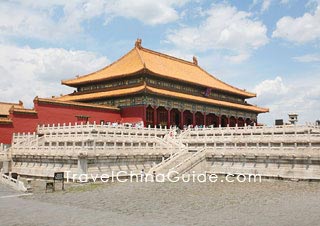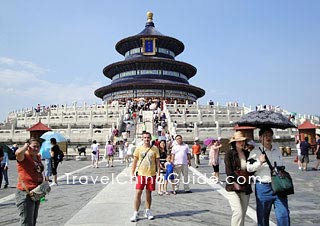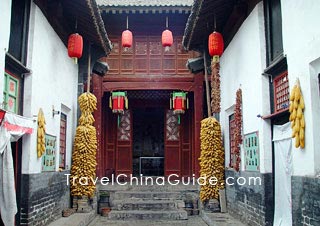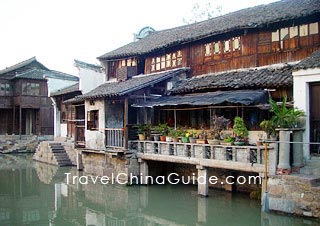Architecture and culture are tightly related to each other. In a sense, architecture is the carrier of culture. Styles of Chinese ancient architecture are rich and varied, such as temples, imperial palaces, altars, pavilions, official residencies and folk houses, which greatly reflect ancient thought - the harmonious unity of human beings with nature.
You may find much Chinese ancient architecture, is often composed of small yards. Instead of pursuing the over-dimensioned architecture such as western cathedrals, Chinese ancient people designed housings fit human dimensions so that they may feel intimate and safe, and this idea reflects the practical thinking in Chinese culture.
Chinese people practice moderation in all things and they don't lay emphasis on strong self-expression but seek modesty and gentleness. The influence of this spirit on architecture is characterized by pursuing sense and connotation. Usually, the front of Chinese architecture is simply plain walls that cannot catch your eyes, but when you patiently walk inside, you will find the best feature is waiting in the farthest inside like a shy girl slowly uncovers her veil.
Two typical types of Chinese ancient architecture represent the profound influence of Chinese culture are Fengshui and Memorial arch.
: traditional theory especially directs the process of architectural construction on the basis of the culture of the Book of Change. Its emphasis is concerned with the harmonious unity of human beings with nature.
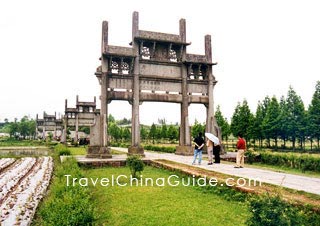 |
Tangyue Memorial Archways,
Shexian County, Huangshan |
Paifang, or arch in English, is a wooden or stone archway built mainly to commemorate the great achievements or loftiness of a family's ancestors. It is often erected in front of a tomb, temple, and ancestral hall or along the road. Many beautiful lucky birds or beasts, exquisite flower patterns, or characters written by celebrities are carved on the arch.
Paifang symbolizes Chinese culture and has a long history. Early in the middle of the Spring and Autumn Dynasty (770 BC-476 BC), there was an architectural style, Hengmen, which was composed of two pillars supporting a beam. This style is supposed to be the precursor of Paifang. In the past, it was a very serious and ceremonious event to erect a Paifang.
Paifang can be divided into three types according to their different functions. 'Loyalty' Paifang is used to record a person's merit or great deeds. For example, Emperor Wanli in the Ming Dynasty (1368-1644) once ordered a loyalty Paifang to be built for Wang Xiangqian to honor his contribution to the country. If a person passed the imperial examinations, his family members would erect a Paifang because he brought honor to their ancestors. The 'Chastity' arch is built to honor a woman's loyalty to her husband. Other Paifang may contain little deep meaning; serving only as a symbol of a street or a village.
Each Paifang has its own cultural connotation and symbolization which are expressed in the beautiful colored patterns. The common designs on Paifang include dragon and phoenix, bat, deer and fish. The Paifang decorated with dragons and phoenix must belong to a royal family, because the dragon is the king of beasts and represent the emperor, while the phoenix is the queen of birds and represents the empress. 'Bat', in Chinese, is 'bianfu', with pronunciation similar to 'fu' (blessing); so the bat is regarded as a symbol of good luck and happiness. Deer sounds similar to 'lu' (salary), signifying promotion. Fish are carved on Paifang to represent the passing of an important test, an imperial examination, for example. Additionally, cypress, tortoise, water lily, peony and lotus leaf are often painted on Paifang to express the rich cultural connotation such as longevity, healthy, luck, happiness and so on.
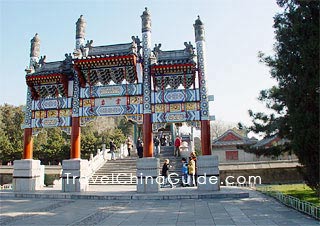 | | A Colored Archway, Summer Palace | | 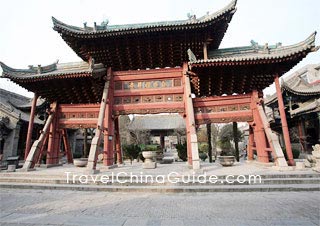 | | Wooden Arch of Great Mosque, Xi'an | |
Different styles of Paifang can be seen in most part of China. In the north, Paifang is majestic with some royal features. Some famous ones are Paifang in the
Summer Palace and
Great Mosque in Xi'an. In the South, Paifang designs are exquisite. In
Shexian - 'Town of Arch' around Huangshan City, Paifang is regarded as one of the 'Three Wonders of Ancient Architecture'. Here stand many famous arches, such as the Eight-Posted Archway, and the Four-Posted and Four-Bronted Memorial Arch.

